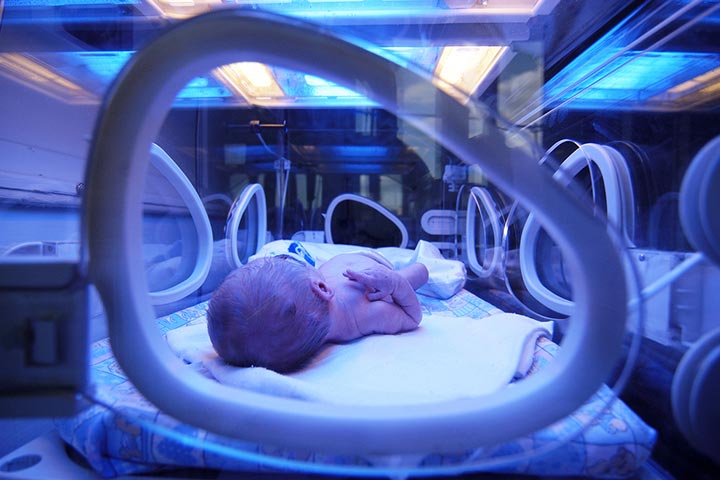Image: Shutterstock
Congenital brain defects or malformations are a group of brain disorders or defects in infants during fetal life and present at birth. Various genetic and environmental factors can contribute to this condition. Brain defects may occur during the initial weeks of pregnancy, particularly during the first 12 weeks since the brain develops shortly after conception.
Read this post to know about the symptoms, causes, diagnosis, treatment, and outlook of congenital brain defects in babies.
Types Of Congenital Brain Malformations
The following types of congenital brain defects are often seen in babies (1).
- Chiari malformation is when the part of the brain called the cerebellar tonsils protrudes to the upper spine through the skull opening. This may increase the pressure on the spinal cord and brain, blocking the normal flow of cerebrospinal fluid (CSF).
- Encephaloceles is a neural tube defect that causes the brain to bulge out from the cranial cavity without being covered by skin or skull bone. This can often result in hydrocephalus and infections. Surgical closure and CSF drainage are required to treat this condition.
- Arachnoid cysts are common brain cysts present at birth and occur due to the splitting of the arachnoid membrane of the brain. These cysts are fluid-filled and often require surgical treatment.
- Anencephaly is a cephalic disorder caused by the absence of a major portion of the brain and skull. This is a type of neural tube defect (NTD).
- Holoprosencephaly is a structural birth defect where the brain does not divide into two hemispheres.
- Microcephaly is a condition when the brain fails to develop into its average size.
- Megalencephaly is when the brain is larger than normal.
Signs And Symptoms Of Congenital Brain Defects
Signs and symptoms of congenital brain defects may vary depending on the type of defect. Growth and developmental delay are seen in most babies. However, some babies may not have any symptoms during early childhood, and it can be an incidental finding on MRI.
Common signs and symptoms seen in congenital brain defects may include (2):
- Seizures
- Developmental delays
- Muscle weakness and increased or decreased muscle tone
- Large or small head size
- Vision and hearing impairments
- Bowel and bladder issues
- Abnormal primitive reflexes
- Hydrocephalus
- Feeding difficulties
Babies with congenital brain abnormalities can also have associated cleft lip and palate, gastrointestinal defects, and cardiovascular defects. Babies with blocked CSF flow can develop hydrocephalus. Mild cases of Chiari malformations may not cause symptoms in early childhood, and it is often diagnosed later during MRI for headaches or other causes.
Risk Factors And Causes Of Congenital Brain Defects
There may not be a specific cause in most cases of congenital brain defects. However, various environmental and genetic factors are often linked to brain malformations (3) (4).
- Inherited or sporadic genetic mutations
- Trisomy of chromosome 9 cases Chiari II defects (involves displacement of the medulla of the brain and lumbosacral spinal myelomeningocele) and Dandy-walker syndrome (underdeveloped cerebellum)
- Trisomy of chromosome 13 causes microcephaly and holoprosencephaly
- Trisomy 13 and 18 may cause neural tube defects.
- Prenatal bacterial and viral infections
- Maternal drug and other substance use
- Trauma to the fetus such as falling on the stomach during pregnancy
The following factors may increase the risk for congenital brain defects (4).
- Certain medications and radiation
- Nutritional deficiencies
- Maternal diabetes
- Phenylketonuria (PKU)
- Traveling to areas with known outbreaks and not getting vaccines can increase the risk of maternal bacterial or viral infections
Maternal infections such as varicella-zoster, rubella, and herpes simplex can significantly increase the risk of congenital brain abnormalities in babies.
Diagnosis Of Congenital Brain Defects
Pediatric neurologists evaluate babies with suspected congenital brain malformations to diagnose and treat the problem. Physical examination, including the neurological examination and health history and brain imaging such as MRI scan, help to confirm the congenital brain anomalies. MRI scans help to visualize the brain malformations in most cases (1).
Cranial (head) ultrasound can help visualize newborns’ brains since their skull bones are not completely formed. Genetic testing of the baby and parents are often done in certain cases if a congenital brain anomaly is associated with genetic conditions.
Treatment For Congenital Brain Defects
Treatment options for brain defects may vary depending on the type and severity of the defect. Multidisciplinary approaches are often required to manage brain malformations. Geneticists, craniofacial plastic surgeons, neurosurgeons, and a few other specialists are often involved in the care.
Mild brain malformations that do not cause severe problems may not require specific treatment and are observed regularly. Most babies may receive the following treatments to reduce symptoms (1).
- Anticonvulsant or antiseizure medications to reduce seizure episodes
- Chiari decompression surgery is done to widen the foramen magnum by removing bone to make space for the brain in the skull
- Cranial surgeries to correct skull deformations help the brain to grow normally
- Shunts are created in hydrocephalus to drain cerebrospinal fluid
Pediatric neurosurgeons schedule follow-up visits after surgical procedures to track the progress and recovery.
Outlook For Congenital Brain Defects
The prognosis of congenital brain defects may vary depending on the severity and type of brain defect. In addition, mental and physical impairment and environmental factors may contribute to the prognosis.
Minor neurological defects are present in most cases. However, people with minor defects can grow and function independently. Some brain effects can significantly disable the child and often limit their mental functioning to below average. Severe cases can be fatal before or soon after birth.
Prevention Of Congenital Brain Defects
Some cases of congenital brain defects cannot be prevented. However, the following measures during pregnancy may reduce the risk of brain malformations in some babies (5).
- Take daily recommended amount of folic acid before conception and during the pregnancy
- Seek early prenatal care
- Become up to date with vaccines, including the annual influenza vaccine (flu shot) during pregnancy
- Try to reach a healthy weight before planning pregnancy
- Keep chronic conditions such as diabetes and hypertension under control
- Maintain a balanced and healthy diet, with adequate physical activities during pregnancy
- Avoid harmful substances such as alcohol, tobacco, or recreational drugs during pregnancy
In addition to these tips, you may also make your house mosquito-proof. You must use mosquito repellants while traveling to areas with mosquito-borne illnesses, such as the Zika virus infection, that cause congenital brain malformations. Congenital malformations such as neural tube defects can be prevented with an adequate intake of prenatal vitamins, such as folic acid.
Congenital brain defects may affect different babies differently. Babies with severe disabilities may require various therapies and training to improve their quality of life. You may seek support from online groups or local groups if needed. Never miss the follow-up visit scheduled for your baby and talk to the pediatrician to know about special programs for care and rehabilitation of babies with congenital brain defects.


































